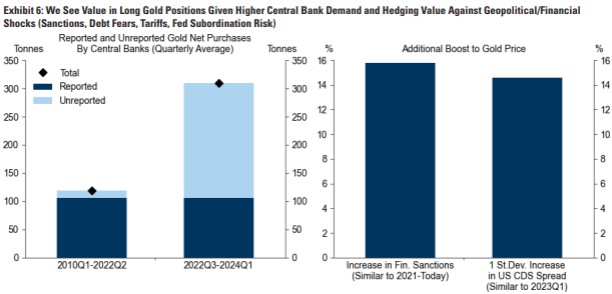Gold to hit $2,700 in early 2025 amid softening cyclical environment – Goldman Sachs
NEW YORK (September 4) Commodities are often seen as a safer go-to investment than stocks during times of economic strife as they make up the base materials that fuel the engines of society, but according to Goldman Sachs, the current environment is risky for most popular commodities, and gold offers the best protection against the loss of value.
“We strongly believe in the diversifying role of commodities in investment portfolios based on several structural drivers, including commodities’ hedging role against supply disruptions, not an uncommon occurrence in energy, and the potential for sharp rallies in select industrial metals driven by a combination of long supply cycles and structural green metals demand growth associated with energy security and decarbonization investment,” analysts at Goldman Sachs wrote in their recent commodities update.
“However, given the current softening cyclical environment, we opt to tactically close our 2024 Deficits Basket trading recommendation with a potential gain of 8% and focus on our highest conviction views in the current environment, namely higher implied oil volatility, long gold and short long-dated European gas,” they added.
While they have closed the book on multiple commodity-focused investments, Goldman’s analysts said, “Gold stands out as the commodity where we have the highest confidence in near-term upside.”
They continue to hold a bullish target of $2,700 per ounce for early 2025 and have opened a gold trading recommendation for three reasons.
First, the analysts said they “believe that the tripling in central bank purchases since mid-2022 on fears about US financial sanctions and US sovereign debt is structural and will continue,
reported or unreported.”
Second, they said, “Imminent Fed rate cuts are poised to bring Western capital back into the gold market, a component largely absent of the sharp gold rally observed in the last two
years.”
Finally, the analysts said that gold “offers significant hedging value to portfolios against geopolitical shocks including tariffs, Fed subordination risk, and debt fears.”
“Our analysis suggests an upside of 15% in gold prices under a hypothetical rise in financial sanctions equal to the rise seen since 2021 and a similar upside if US CDS spreads widen by 1,” they wrote. “That said, due to the particularly price-sensitive Chinese market digesting the recent price rally, we have adjusted our $2,700 target to early 2025 vs year-end 2024 previously. However, we believe that that same price sensitivity also insures against hypothetical large price declines, which would likely reinvigorate Chinese buying.”

Source: World Gold Council, IMF, Company data, Goldman Sachs Global Investment Research
Expectations for continued gold buying by central banks are warranted after they purchased the largest amount of gold on record in H1 2024.
“Global net gold purchases by central banks reached 483 tonnes in the first half of 2024, the most on record,” noted the Kobeissi Letter. “This is 5% higher than the previous record of 460 tonnes set in the first half of 2023.”
“In Q2 2024, central banks bought 183 tonnes of gold, marking a 6% year-over-year increase,” they added, before noting that “this was 39% lower than the 300 tonnes of purchases seen in Q1.”
The surge in gold buying led the Kobeissi Letter to ask a pertinent question: “Why are central banks calling for a ‘soft landing’ while stocking up on gold?”
While Goldman is bullish on gold heading into the end of 2024 and the beginning of 2025, and the Kobeissi Letter sees demand from central banks continuing to push it higher, the yellow metal must first get through September, which has been a bear of a month going back to 2016.
But with governments worldwide continuing to print debt like there is no tomorrow, there’s a strong chance that the strength shown by gold in the first half of 2024 will continue in the second half and beyond as the primary result of debt printing is currency debasement.
KitcoNews











